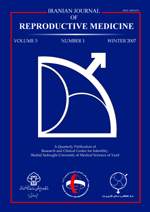
|
International Journal of Reproductive BioMedicine
Research and Clinical Center for Infertility, Shahid Sadoughi University of Medical Sciences of Yazd
ISSN: 1680-6433
EISSN: 1680-6433
Vol. 15, No. 6, 2017, pp. 351-356
|
 Bioline Code: rm17046
Bioline Code: rm17046
Full paper language: English
Document type: Research Article
Document available free of charge
|
|
|
International Journal of Reproductive BioMedicine, Vol. 15, No. 6, 2017, pp. 351-356
| en |
Comparing the effect of gonadotropin-releasing hormone agonist and human chorionic gonadotropin on final oocytes for ovulation triggering among infertile women undergoing intrauterine insemination: An RCT
Taheripanah, Robabeh; Zamaniyan, Marzieh; Moridi, Atefeh; Taheripanah, Anahita & Malih, Narges
Abstract
Background: The purpose of triggering in ovulation induction is to induce the final
maturation of oocytes and their release from the ovary for fertilization.
Objective: The aim of the present study was to compare the effectiveness of
gonadotropin-releasing hormone (GnRH) agonist and human chorionic
gonadotropin (HCG) on the final maturation of oocytes and pregnancy rates in
intrauterine insemination (IUI) cycles.
Materials and Methods: In this randomized clinical trial, 110 infertile women who
were selected for IUI entered the study. Ovulation induction was performed. Group I
received 0.1 mg GnRH agonist as triggering and group II received 10,000 IU of
HCG. The serum Estradiol (E2), Luteinizing Hormone (LH), and Follicle-Stimulating Hormone (FSH) levels were measured at 12 and 36 hr after injection.
Results: LH surge was detected in all patients. LH levels at 12 and 36 hr after
triggering was higher in Group I and it washed out earlier than group II (p=0.00).
The pregnancy rate was higher in Group I, but the difference was not statistically
significant (26.9% vs. 20.8%, respectively p=0.46). Also, the incidence of ovarian
hyperstimulation syndrome was not different between the two groups (p=0.11).
There was a significant difference regarding the estradiol levels at 36 hours after
triggering (p=0.00).
Conclusion: Effects of GnRH on endogenous LH surge is sufficient for oocyte
releasing and final follicular maturation. Pregnancy rates and ovarian
hyperstimulation syndrome incidence were not different between the groups. We
suggest that GnRH agonists might be used as an alternative option instead of HCG
in IUI cycles.
Keywords
Gonadotropin-Releasing Hormone; Chorionic gonadotropin; Insemination; Artificial; Ovulation; Pregnancy
|
| |
© Copyright 2017 - International Journal of Reproductive BioMedicine
Alternative site location: http://www.ijrm.ir
|
|
